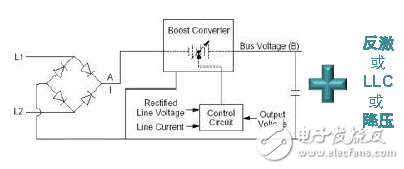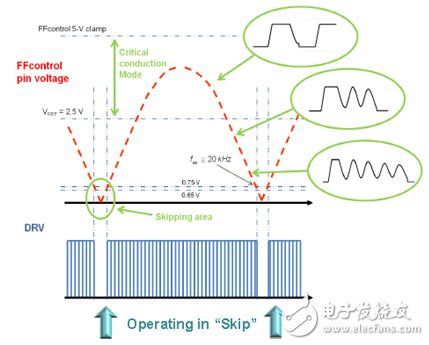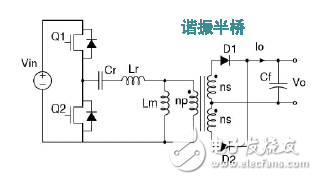The many advantages of LEDs have gradually replaced traditional light sources such as incandescent lamps and fluorescent lamps, and they are increasingly appearing in our daily work and life in low-power applications, and within our traditionally defined medium to high power range of 20 to 400 watts. Fluorescent lamps and high-intensity discharge lamps are still in the mainstream. However, with the continuous development of high-power LED products, the emergence of modular LED strips, large arrays of LEDs, etc., LEDs are increasingly appearing in applications such as roads, stadiums, and outdoor large-scale facilities that require high-power lighting. The figure.
LED lighting circuit is relatively simple in design, can be integrated and controlled, can easily realize dimming, and can effectively reduce power consumption. Therefore, in today's emphasis on smart and green lighting, medium and high power LED products gradually replace traditional light sources such as high-intensity discharge lamps (HID). It is already the general trend. However, we also see that modular LED strips and arrays have different requirements for power supply. How to provide reliable, efficient and flexible drive power solutions for medium and high power LED lighting products is a common challenge for designers. ON Semiconductor is actively promoting energy-efficient innovations, leveraging its extensive experience in the power supply field to provide applications in different areas of LED lighting. And for the different needs of medium and high power LED lighting applications, ON Semiconductor provides power factor correction (PFC) controllers, quasi-resonant and fixed frequency flyback controllers and switching regulators, integrated MOS buck controllers, and half Bridge controllers and LLC controllers, secondary controllers, integrated controllers with integrated PFC and PWM, and other solutions to meet the different needs of different circuit topology design.
Single-stage power factor correction (PFC) solution
Power factor correction (PFC) can effectively improve the pressure of high harmonic components on power lines, disconnect switches, and power facilities. PFC controllers can generally be divided into single-stage and multi-stage (common two-stage) structures. Single-stage (shown in Figure 1) can be driven directly by current, requiring only a single switch and magnetic components. The disadvantage is 100/120Hz ripple, MOSFET stress is greater, duty cycle is greater, and power is limited to 100-150W.

Figure 1. Schematic diagram of a single-stage PFC structure
A typical single-stage PFC LED driver solution is like the NCL30000 from ON Semiconductor. The device uses a critical conduction mode (CrM) flyback architecture to provide a high power factor design in a single segment topology. ON Semiconductor's 25 W high power factor single-segment LED driver reference design based on the NCL30000 accepts a wide input voltage range of 90-305Vac with energy efficiency greater than 87%, input current total harmonic distortion (THD) less than 15%, and power factor ( PF) is greater than 0.97, output power is 25W (Vf = 36Vdc), LED current is 700mA ± 4%, and maximum LED voltage is 44Vdc. ON Semiconductor also introduced the single-stage continuous current mode (CCM) PFC LED driver NCL30001, which can be configured as a constant current driver or a fixed output voltage driver for 40W to 150W LED lighting designs.
Two-stage PFC + DC-DC conversion scheme
In addition to the single-stage solution described above, designers can also choose the traditional two-stage (PFC section + DC-DC conversion section) solution according to the application requirements (as shown in Figure 2). The function of the front-end PFC is to realize input current shaping on the one hand to reduce the input current harmonics, and on the other hand to convert the input AC voltage into a stable DC voltage (the variation range is generally 380V-400V), and the latter stage DC-DC converter realizes Isolation and conversion, which converts the regulated DC voltage to the required voltage, usually implemented by flyback, LLC or buck. The advantage is that it is easy to expand the power and size, and it is easy to provide the secondary side bias supply, but it will bring Cost increase.

Figure 2. Schematic diagram of a two-stage PFC structure
Specifically, the controllers that can be selected for the PFC segment in the two-stage scheme include NCP1605, NCP1611/ NCP1612/ NCP1615, NCP1631, MC33262/NCP1607/NCP1608, NCP1653/NCP1654, NCP1652A/NCL30001, and the like.
Among them, NCP1605 is an enhanced high-voltage, energy-efficient standby mode power factor controller operating in fixed frequency discontinuous conduction mode (DCM) and / or critical conduction mode (CrM). The NCP1605 can operate as a PFC master, ensuring that the second segment of the power supply is only started under safe conditions. It integrates a skip cycle function to minimize standby losses.
The NCP1631 is a single-chip 2-phase interleaved PFC controller from ON Semiconductor that can replace two NCP1601s and drive two PFC branches to provide a high power factor close to one.
When using the traditional CrM/BCM control, the switching frequency increases when the load is reduced. When the load is light, the controller may enter the “burst frequency modulation mode†to generate noise. When the current control frequency reverse (CCFF) control is used, the switch is reduced when the load is reduced. The frequency is reduced, the noise is reduced, the controller frequency is lower at light load, the frequency clamp can be clamped above the audible frequency band, and the jump cycle mode is used when the load is very light, which can be turned off to improve the better THD, and the bottom is turned on. Further improve energy efficiency and reduce electromagnetic interference (EMI) (as shown in Figure 3). The NCP1611/NCP1612 is based on the innovative CCFF architecture. When the PFC inductor current exceeds the set value, the circuit normally operates in critical conduction mode (CrM), and when the current is lower than the preset value, the switching frequency is linearly reduced to approximately 20 kHz. At this point the current is zero. The NCP1615 is also based on the CCFF architecture. When the current is below the preset level, the control frequency of the NCP1615 chip is linearly attenuated to 26KHz.

Figure 3. Principle of the current control frequency back-off (CCFF) architecture
For the two-stage solution, in the high-voltage DC-DC secondary section, the single-switch flyback architecture (shown in Figure 4) is energy efficient and simple in design, but the power design is typically less than 100W. As the industry's leading supplier of fixed frequency and quasi-resonant (QR) control solutions, ON Semiconductor offers quasi-resonant fixed frequency flyback control ICs with high voltage start, QR valley lock, robust fault protection, and wide product range (lowest controller) 6 pins) and other features. It is the first in the industry to introduce the first generation of high-voltage quasi-resonant flyback control chip NCP1207/NCP1308, to the second generation NCP1337/NCP1338 which provides more protection functions, and then to the third generation of NCP1380 with light load efficiency and greatly improved, until the latest fourth On behalf of the NCP1339, which improves the no-load energy consumption, ON Semiconductor has been working hard to develop more chip products that meet the broader needs of customers.

Figure 4. Schematic diagram of the high-voltage DC-DC secondary-side flyback topology
Compared to other resonant topologies, the LLC series resonant converter (shown in Figure 5) is capable of operating over a relatively wide range of input voltages and outputs; fewer components are required, and resonant energy storage components can be integrated into a single In the transformer; the primary side switch can achieve zero voltage switching (ZVS) under all rated load conditions; the secondary side diode can realize zero current switching (ZCS) without reverse recovery loss, so it is a cost-effective, energy-efficient and Low EMI solution, often used in high output voltage applications.
As the fifth-generation high-performance LLC series resonant controller, NCP1398 can operate from 50kHz to 750kHz, with adjustable minimum switching frequency accuracy of ±3%, adjustable dead time, externally adjustable soft-start, precision and high impedance. Input undervoltage protection for latching input pins under severe fault conditions such as overtemperature or overvoltage, timer-based auto-recovery overcurrent protection, latch output short-circuit protection, on/off control off input pin, skip cycle mode With adjustable hysteresis, Vcc operating voltage up to 20V, common collector optocoupler connection, simplified Oring control, built-in overtemperature shutdown, 600V half-bridge driver with 1A/0.5A 汲/source drive capability, NCP1398B also provides feedback loop Open circuit protection.

Figure 5. Schematic diagram of high-voltage DC-DC secondary-side LLC series resonance
Combined controller solution
The NCL30051 is a PFC and resonant half-bridge combination controller that integrates a CrMPFC controller and a half-bridge resonant controller with a built-in 600 V driver optimized for off-line power applications in a SOIC16 package. Achieve the features required for energy efficient, small form factor designs. Compared to the traditional approach of CrM PFC+LLC to control power by changing the LLC frequency, the NCL30051 changes the PFC bulk voltage to control power. The limitation is the dynamic range of the large capacitor voltage. The advantage is that the fixed voltage LED driver design is simplified.
to sum up
LED lighting is evolving rapidly, and new drive solutions need to be able to match the latest LED applications on the market; while the choice of topology is also evolving to improve energy efficiency and reduce overall system cost. In order to meet the needs of medium and high power LED lighting drivers, ON Semiconductor has provided a wide range of complementary and complementary solutions, including single-stage PFC solutions and two-stage PFC+DC-DC conversion solutions to meet different medium and high power LED lighting. Application requirements.
MAINTEX's Other Products included: barrier gate , Fan Motor , Micro stepper motor, Unipolar Stepper Motor, Air Purifier Motor, Hvac Blower Motor, Planetary Gear Motor , 775 Gear motor , Helical Gear Motor, Electric Wheelchair Motor, Meat Grinder Motor, Lawn Lower Motor, Vending Machine Motor, 3D Printer Motor, Printer Motor, Treadmill Motor, Robot Motor, Feeder Motor, etc. Welcome to contact us to buy or customize, we provide OEM and ODM customized services for various motors.
Other Products
Fan Motor,Micro Stepper Motor,Unipolar Stepper Motor,Linear Stepper Motor
Shenzhen Maintex Intelligent Control Co., Ltd. , https://www.maintexmotor.com